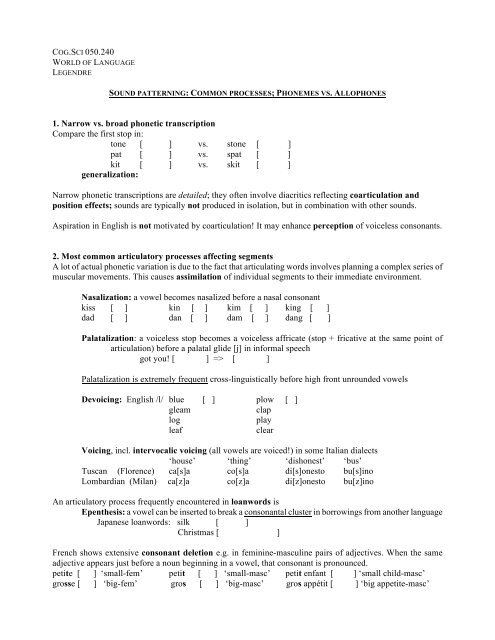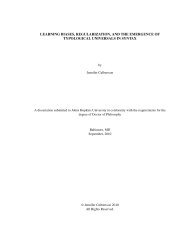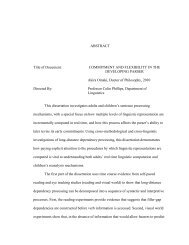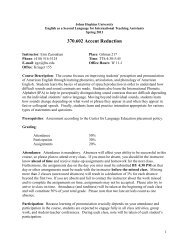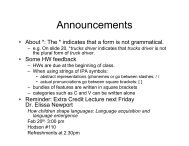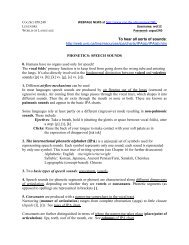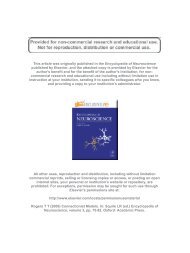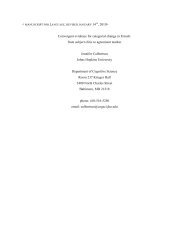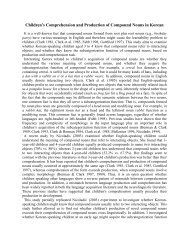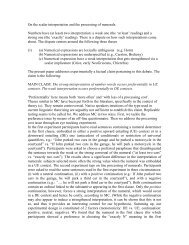Phonemes
Phonemes
Phonemes
Create successful ePaper yourself
Turn your PDF publications into a flip-book with our unique Google optimized e-Paper software.
COG.SCI 050.240<br />
WORLD OF LANGUAGE<br />
LEGENDRE<br />
SOUND PATTERNING: COMMON PROCESSES; PHONEMES VS. ALLOPHONES<br />
1. Narrow vs. broad phonetic transcription<br />
Compare the first stop in:<br />
tone [ ] vs. stone [ ]<br />
pat [ ] vs. spat [ ]<br />
kit [ ] vs. skit [ ]<br />
generalization:<br />
Narrow phonetic transcriptions are detailed; they often involve diacritics reflecting coarticulation and<br />
position effects; sounds are typically not produced in isolation, but in combination with other sounds.<br />
Aspiration in English is not motivated by coarticulation! It may enhance perception of voiceless consonants.<br />
2. Most common articulatory processes affecting segments<br />
A lot of actual phonetic variation is due to the fact that articulating words involves planning a complex series of<br />
muscular movements. This causes assimilation of individual segments to their immediate environment.<br />
Nasalization: a vowel becomes nasalized before a nasal consonant<br />
kiss [ ] kin [ ] kim [ ] king [ ]<br />
dad [ ] dan [ ] dam [ ] dang [ ]<br />
Palatalization: a voiceless stop becomes a voiceless affricate (stop + fricative at the same point of<br />
articulation) before a palatal glide [j] in informal speech<br />
got you! [ ] => [ ]<br />
Palatalization is extremely frequent cross-linguistically before high front unrounded vowels<br />
Devoicing: English /l/ blue [ ] plow [ ]<br />
gleam clap<br />
log play<br />
leaf clear<br />
Voicing, incl. intervocalic voicing (all vowels are voiced!) in some Italian dialects<br />
‘house’ ‘thing’ ‘dishonest’ ‘bus’<br />
Tuscan (Florence) ca[s]a co[s]a di[s]onesto bu[s]ino<br />
Lombardian (Milan) ca[z]a co[z]a di[z]onesto bu[z]ino<br />
An articulatory process frequently encountered in loanwords is<br />
Epenthesis: a vowel can be inserted to break a consonantal cluster in borrowings from another language<br />
Japanese loanwords: silk [ ]<br />
Christmas [ ]<br />
French shows extensive consonant deletion e.g. in feminine-masculine pairs of adjectives. When the same<br />
adjective appears just before a noun beginning in a vowel, that consonant is pronounced.<br />
petite [ ] ‘small-fem’ petit [ ] ‘small-masc’ petit enfant [ ] ‘small child-masc’<br />
grosse [ ] ‘big-fem’ gros [ ] ‘big-masc’ gros appétit [ ] ‘big appetite-masc’
2<br />
See textbook, Ch. 2 for additional articulatory processes: dissimilation, vowel reduction, and metathesis.<br />
ð Crucial observation: all these processes are systematic in a language: They apply to classes of sounds.<br />
3. Suprasegmental properties<br />
are typically independent of particular segments in a language.<br />
Length (of segment): IPA symbol ‘:’ (= colon)<br />
short vs. long vowels in German:<br />
Stadt [ ] ‘city’ Staat [ ] ‘state, e.g. of Maryland’<br />
wenn [ ] ‘whom’ wen [ ] ‘when’<br />
bitten [ ] ‘to request’ bieten [ ] ‘to wish’<br />
short vs. long consonants in Italian:<br />
fato [ ] ‘fate’ fatto [ ] ‘fact’<br />
vano [ ] ‘vain’ vanno [ ] ‘they go’<br />
beve [ ] ‘he drinks’ bevve [ ] ‘he drank’<br />
H<br />
Tone: differences in pitch Chinese high tone [ma] ‘mother’ (register tone)<br />
MLH<br />
fall rise [ma] ‘horse’ (contour tone)<br />
MH<br />
mid rise [ma] ‘hemp’ (contour tone)<br />
HL<br />
high fall [ma] ‘scold’ (contour tone)<br />
Notation: H (high), M (mid), L (low) on line above with association line.<br />
Stress: relative prominence of syllables<br />
Notation: acute accent on vowel nucleus for primary stress, e.g. [é]<br />
grave accent for secondary stress, e.g. [è]<br />
English desert [ ] dessert [ ]<br />
(a) record [ ] to record [ ]<br />
4. Not all sounds are equal in a language!<br />
Within a language some sounds have a privileged status in that they carry the burden of encoding differences in<br />
meaning. They are called phonemes. Others (called allophones) are phonetically close variants of existing<br />
phonemes; their typically single distinct phonetic property is predictable from their phonetic environment.<br />
<strong>Phonemes</strong> are contrastive sounds (represented as / /).<br />
Test: contrastive or minimal pairs (see also near-minimal pairs)<br />
pat, bat fat, vat sit, zit sit, sat<br />
Are the following minimal pairs?<br />
boat, bought sheep, Jeep<br />
loose, lost now, no
Non-contrastive, predictable sounds are called allophones (represented as [ ])<br />
Test: complementary distribution<br />
tone [ ] stone [ ] pot [ ] or [ ]<br />
pit [ ] spit [ ] tip [ ] or [ ]<br />
kin [ ] skin [ ] nik [ ] or [ ]<br />
Main phonetic environments: word-initial, word-final position; between vowels; after/before a specific sound.<br />
When a given word can have more than one pronunciation in the same phonetic environment, allophones are said<br />
to be in free variation: e.g. stop [stɑp] or [stɑp˥] ˥ = unreleased stop (IPA diacritic)<br />
5. Procedure for determining phonemes in any language<br />
a) List the phonetic environments in which the sounds in question appear<br />
b) Do the sounds occur in the same environment?<br />
- No, the sounds are in complementary distribution => they are allophones of the same phoneme<br />
- Yes, the sounds are in overlapping distribution<br />
=>They are allophones in free variation if the words have the same meaning OR<br />
=>They are allophones of different phonemes if the words form minimal pairs<br />
Pairing sounds with phonetic environments:<br />
[ ] [ ] [ ] in word-initial position<br />
[ ] [ ] [ ] immediately following [s]<br />
[ ] [ ] [ ] in word-final position<br />
[ ] [ ] [ ] in word-final position<br />
How many variants of [t], [p], [k] are there (in this example)? __________________________________<br />
What is the generalization governing their distribution? _______________________________________<br />
Important: Allophonic variation involves pairs of speech sounds that are very similar in all features (e.g.<br />
manner, place of articulation, etc.) except for one (e.g. voicing, aspiration, etc.; see 6. below)<br />
Which allophone is identified as the phoneme (the underlying form from which all allophones are derived)?<br />
It is usually the allophone with the widest distribution (it is known as the elsewhere variant because it subsumes<br />
several distinct phonetic environments).<br />
e.g. English / / / / / /<br />
[ ] [ ] [ ] [ ] [ ] [ ] [ ] [ ] [ ]<br />
elsewhere elsewhere elsewhere<br />
6. For a given sound, its status (phoneme vs. allophone of an existing phoneme) varies in different languages<br />
Khmer [pɔ:ŋ] 'to wish' [p h ɔ:ŋ] 'also'<br />
[tɔp] 'to support' [t h ɔp] 'be suffocated'<br />
[kat] 'to cut' [k h at] 'to polish'<br />
French [vĩ] ‘wine’ [põ] ‘bridge’ [sã] ‘blood’<br />
[vi] ‘life’ [po] ‘jar’ [sa] ‘his,her’<br />
Note: Nasalized vowels are not the same thing as nasal vowels; their status is different!<br />
3
Tagalog [datiŋ] 'to arrive' [daraʔiŋ] 'will complain'<br />
[dami] 'amount' [marumi] 'dirty'<br />
[dumi] 'dirt' [marami] 'many'<br />
[daratiŋ] 'will arrive' [daʔiŋ] 'to complain'<br />
[mandurukot] ‘pickpocket’ [mandukot] 'to go pickpocketing'<br />
7. Phonetic vs. phonemic inventories<br />
For a given language it is necessary to establish both a phonetic inventory and a phonemic inventory.<br />
The phonemic inventory of a language is always a subset of a phonetic inventory. It is obtained by analysis, not<br />
direct elicitation.<br />
8. Production vs. perception of speech<br />
Speakers pronounce allophones.<br />
Hearers have a hard time perceiving phonetic differences that are not contrastive because they are typically<br />
focused on interpreting what they hear.<br />
9. Alphabetic spelling systems generally ignore phonetic variation that is not contrastive. They typically encode<br />
phonemes only.<br />
4


